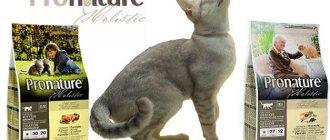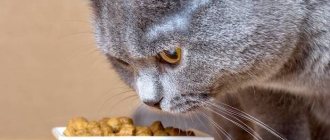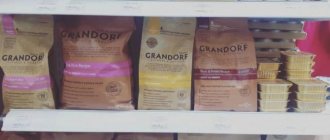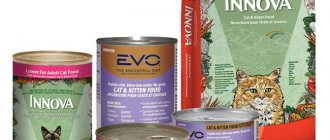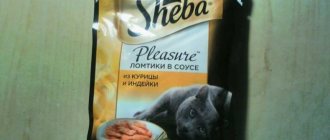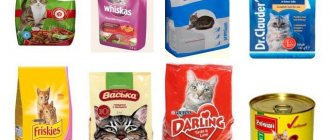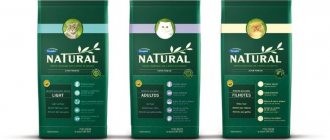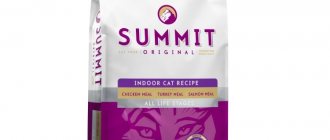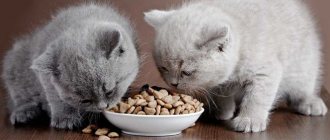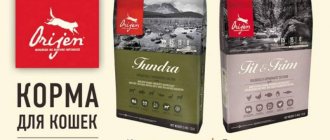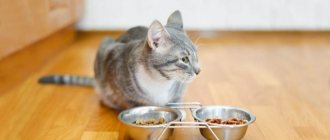For many specialists, as well as for dog and cat owners, the division of industrial food into classes is an immutable truth. They believe that since “super premium” is written on a package of food, this automatically guarantees decent quality ingredients, high digestibility and availability of nutrients, and if the word “holistic” is included in the description of the diet, then such a product is absolutely excellent in quality and composition, and is perfect for a pet.
Unfortunately, this is often only the perception of consumers, imposed by the competent actions of marketers, sales agents and “ambassadors” of a particular brand.
The principle of “divide and conquer”
The idea that some classes of food are better than others has firmly taken root in the minds of consumers, and we realized that it is high time to talk about what types of food there are, or rather, what the classification of animal food is in detail and frankly.
We would like to clarify some important points and help you avoid falling for the marketing scams of manufacturers and sellers.
The need to classify dry food arose among manufacturers of ready-made diets when the feed industry began to actively develop. New, more expensive diets appeared, and the question arose of how manufacturers could promote such foods and win the attention of consumers. After all, each manufacturer was not averse to presenting the advantages of their product as best as possible and highlighting the disadvantages of competitors.
Also, the classification of feed into classes is useful for large concerns that produce feed products in different price categories for different groups of consumers - this makes it easier for them to explain the differences between their many brands.
Holistic
The classification of dry food would be incomplete without mentioning the holistic category. These foods appeared in our country not so long ago, but have already won the trust of domestic consumers. Having analyzed their composition, we can come to the following conclusion: they are in many ways similar to super premium, with the exception of some improvements:
- the list of ingredients must include fresh meat (fish);
- these are grain-free or low-grain products; instead of grains, they use legumes, potatoes, vegetables and root vegetables;
- the formula includes various phytocomponents that serve as a natural source of fiber and vitamins, have a positive effect on the functioning of the body, and reduce the smell of feces.
Feed classification is outside the law
You should know that there is no officially accepted industry or any other legal classification of feed quality. Accordingly, there are simply no officially established standards and requirements, confirmed by scientific research, that diets must meet in order to be classified in one or another of the classes.
Rather, the process goes, so to speak, in reverse - this market-imposed gradation of feeds forces interested parties to identify the key distinguishing features of each class in order to understand how the feeds differ.
The current classification can be called the joint “oral creativity” of producers, sellers and buyers. Everyone, at their own discretion and depending on their own benefits or interests, classifies ready-made food as they want.
Class boundaries cannot be determined
We are faced with the fact that a lot of information about the classification of feed available to a wide audience, especially on the Internet, looks reasonable and clear at first glance, but is essentially a figment of the imagination of supporters of one class or another.
You should not believe those who write that “super premium” feed uses the highest quality raw materials, and “economy” feed uses the worst. No matter how much one would like to believe it, everything is far from so simple. There are no clear gradations, for example, between “economy” and “premium”, “premium” and “superpremium”, “superpremium” and “ultrapremium” feeds.
“Feed your pet correctly”: our classification of food
Since at the moment the spontaneous classification of feeds and their characteristics have become very firmly established among consumers, we decided to combine our own knowledge and experience in diet analytics, as well as data from foreign sources, and bring to your attention a summary table of the characteristic features of ready-made complete feeds with additional explanations of the features of each from classes.
Please note that we give all names of feed classes in quotation marks, since these are just names that are not terms.
Below are the characteristics of ready-made food for dogs and cats according to the “Feed Your Pet Correctly” version. You can determine what class of food you have on hand based on these criteria.
| Feed classes | ||||||
| Economy | Premium | Superpremium | Ultrapremium | Holistic superpremium | Biologically relevant | |
| Feed class in the name | ||||||
| The names are attractive, the emphasis is on taste! The words “delicious”, “appetizing”, “fragrant” are often used. | Names often contain information about the age or condition of the animal; less often they are informationally attractive. | The names are often more information-attractive and the emphasis is on the ingredients. | ||||
| Feed class on packaging | ||||||
| The packages are bright, they show photos of happy, cheerful animals. Photos of colored granules are often included. | The packaging is different, often bright and attractive. | The packaging is often bright, with images of purebred animals. | The packaging design usually uses a natural range of shades, but there are also bright, attractive photos of ingredients and views of nature. The animals themselves are sometimes depicted schematically. | |||
| Health icons on packaging | ||||||
| They are present very rarely and without details, all explanations are given in general terms. | Usually present, the packaging provides either general comments or detailed explanations of how the ingredients “work.” | |||||
| Features of feed formulas | ||||||
| Characterized by free formulas, the components in the composition may vary from batch to batch. | Fixed or conditionally free formulas are typical (they may contain ingredients named in groups, but not in such general terms as in “economy” feeds). | Characterized by fixed formulas, the ingredients cannot change depending on the prices of raw materials. | ||||
| Presence of ingredients named by groups | ||||||
| A lot of them. In the composition you can find “meat and offal”, “fish”, “cereals”, etc. | They do occur, but their proportion is different. If such ingredients exist, then the formula cannot be considered fixed. | No | ||||
| Features of ingredient No. 1 | ||||||
| Usually these are mixtures of different components. It is impossible to understand exactly what is contained in them. | Cereal, rarely a meat component. | Mostly meat component | ||||
| Availability of fresh meat and fish | ||||||
| No | Rarely, most often not | More often there is | Eat | |||
| Availability of useful supplements | ||||||
| No | Rarely, most often not | There are, for example, prebiotics, chondroprotectors, and substances for protecting teeth. | Many different additives, including phyto-components. | |||
| Presence of artificial colors and preservatives | ||||||
| Often | Rarely | More often than not | No | |||
| Presence of natural preservatives (tocopherols, rosemary) | ||||||
| No | More often there is | There are, or are used, other natural sources of antioxidants. | ||||
| Sales points | ||||||
| Tents, convenience stores, supermarkets, sometimes pet stores, online trading. | Large supermarkets, pet stores, online trading. | Specialized pet stores, veterinary clinics, rarely supermarkets, online trading. | Specialized pet stores, veterinary clinics, online trading. | Specialized pet stores, online trade. | Specialized pet stores, online trade. | |
Differences between dog and cat food
First of all, it should be noted that the difference between cat and dog food lies in the balance of its components. They contain varying amounts of carbohydrates, proteins and fats. Typically, cat food contains at least 40 percent protein. Mainly, such food should contain enough protein, as well as a large amount of phosphorus. Due to the fact that most cats have fast metabolisms, they require high-calorie food.
When it comes to dog food, it contains mostly fiber, with protein making up about 25 percent. Dog food contains more magnesium, potassium and calcium than cat food.
It has been noticed that the cat’s body does not cope very well with the large volume of grains contained in dog food. If a cat constantly eats dog food, it begins to acutely lack vitamin A. This is fraught with loss of hair in large quantities, as well as complications in the field of vision. Cats require an amino acid called taurine, and this element is not found in dog food. Plus, dog food contains less protein than each cat needs. It also lacks iodine and biotin.
If a dog and a cat live in the same house, they often look into each other's bowls. There are times when owners themselves decide to switch their dog to cat food, thinking at the same time to save money. However, such savings may subsequently result in undesirable results for the pet. For example, too much taurine, which cats need, in a dog's body can cause heart failure. In addition, dogs that consume cat food develop stomach ulcers, gastritis, various gastrointestinal disorders, dermatitis, otitis media, and seborrhea. Small dogs can develop urolithiasis.
Since cats and dogs are different, their food composition is different. As a rule, if a cat eats from a dog bowl once, nothing bad happens. However, with prolonged use of dog food, certain problems may arise for your furry pet. Eating dog food, the cat will suffer from a lack of taurine. In addition, diets specially formulated for dogs contain much higher levels of zinc and vitamin E than cat food. This is fraught with nausea and general malaise. Due to headaches, the cat becomes irritable. Oversaturation with vitamins causes her indigestion, weakness and indifference to everything that happens. Shedding intensifies and claws begin to peel off. Finally, trying to swallow dog food pellets that are too large for her can end sadly for the cat: she will suffocate.
For these and other reasons, it is worth weaning animals from eating other people's food.
It is very useful for dogs to eat food that contains vegetables, fruits, berries, herbs, algae, yeast, glucosamine, chondroitin, probiotics, minerals, and vitamins.
For cats, it is best to consume meat (or its processed products), amino acids, plant products (this can be potatoes, corn, etc.), vitamins K, A, D, E, taurine, iron, copper, manganese, zinc, omega-3 and omega-6 acids.
Economy class
Unlike other classes, you will not find the word “economy” on bags of dog and cat food - it is not in the interests of manufacturers to place it there. The very name of this huge group of products suggests that they are designed for those buyers who are not very picky about the quality of diet for a dog or cat, do not go into details of the composition and want to save money.
Such diets are indeed cheaper than all other options for ready-made food, since they use far from the best raw materials. At the same time, the names of such products mostly try to convince buyers that the diets are very tasty and will appeal to their pets.
Formally, economy-class food contains all the nutrients an animal needs, and the data on protein and fat on the labels in the “Analysis” section meets the standards. These diets are considered balanced, as they contain all the necessary vitamin and mineral supplements.
How to understand that this is an “economy”
A characteristic feature of economy feeds are images of multi-colored granules on the packaging, but if there is no such picture, then this does not mean anything. The main feature of the compositions of this category of food is that almost all the ingredients in the list are indicated in broad groups.
This always indicates the lack of transparency of information about the composition and the fact that the quality of raw materials is not a priority for the manufacturers of these feeds. The formula, that is, the actual composition of the “economy feed” raw materials, can change from batch to batch, in accordance with fluctuations in the prices of the components, which is why it is called free, or non-fixed.
Pets are usually very willing to eat such diets, ask for supplements, and then may refuse higher-quality ready-made food, since the raw materials for such diets may contain various flavoring additives. Such foods are usually not divided by age (at best, there are two options - for kittens/puppies and for adult animals), breeds, or physical condition, but they are often divided by taste.
"Economy" - the most popular and advertised
Many large supermarkets now sell a variety of products, including ready-made animal food, which is produced under the name of the retail chain itself or under their own brand. Most of these ready-made feeds belong to the “economy” class.
It’s sad that it is “economy class” food that attracts buyers by the appearance of its packaging, and they are most often advertised on TV. It is not surprising that the advertising of these brands is truly professional, “tasty” and attractive - huge amounts of money are spent on it, the best agencies work on it. It touches the best feelings, and as a result, buyers automatically transfer the quality of advertising to the quality of the product.
The basic principles for assessing the quality of feed should be clear, clear and exclude any compromises or concessions. We strive to teach you to evaluate not advertising or attractive pictures on the package, but only the list of ingredients.
Economy products occupy a huge niche in the ready-made diet market, but unfortunately, we cannot recommend them as the best option for feeding pets.
Why are feeds divided into classes?
There is a generally accepted division into four price categories: economy, premium, super-premium and holistic. Sometimes ultra-premium is used to show the superiority of the product over others. There are certain standards that each class of food must meet.
Economy class feeds have a low meat content and are often replaced with vegetable proteins. The premium class contains 20-30% meat, but most feeds still contain millet or corn. Sometimes there is something worse, for example, harmful food additives or monosodium glutamate.
The highest quality class of feed is super-premium. The meat content in them reaches 60% and higher. Recently, a new class has appeared on the market - holistic, which includes the best products from the best.
Be careful when choosing food for your pet. Unscrupulous manufacturers often increase the bar for their product. What is written on the front of the package is not always the same as the contents. Read the ingredients, analyze, and only then make a choice. Also beware of fakes.
Premium class
It’s too early to rejoice if you see the inscription “premium quality” on the food label. You should not expect that “premium” ready-made food is as good in its own way as “luxury” high-quality premium brands of perfumes or clothing.
Premium food for dogs and cats has nothing to do with luxury or premium quality. In the finished feed market, this concept is greatly devalued. This is just a group of products that are CONDITIONALLY a little better and more expensive than “economy”, but worse than “super premium”.
The ingredients of “premium” diets are not so different from the composition of “economy class” products, but individual components of slightly better quality can be added to these feeds.
"Premium" ready-made foods are complete and balanced and, of course, are divided by taste, in addition to this they are usually divided by life stages and animal sizes. Sometimes among them there are products for animals with physiological conditions characteristic of dogs and cats - for example, intended for pets after castration and sterilization, or for those who are overweight.
Super premium food
Feeds in this category, which have elite status, contain exclusively first-class and highly nutritious ingredients. Among them are chicken and chicken meat, turkey, lamb, chicken eggs, boiled rice, which is the most easily digestible grain for dogs, and beet pulp rich in fiber. The product also contains category I meat by-products (liver, tongue, kidneys, heart), all of which meet the highest quality standards. Some companies' products contain only those food ingredients that are certified as suitable for human nutrition. The energy value of this product is 360-470 kcal/100 g.
A dog that regularly eats such wonderful food does not need to expand its menu, because such food satisfies not only its nutritional needs. The food is developed taking into account the characteristics of the animal’s digestion, metabolism in its body, and the need for vitamins and minerals. This balanced food is perfectly absorbed: digestibility exceeds 80%. There are also different product options designed for pets of different age groups.
In the production of feed belonging to the elite group, certain technologies are used using gentle heat treatment, which make it possible to preserve proteins and fats in the most natural state. High-quality fats are stabilized with vitamin E. This dog food contains no dyes or preservatives, it has a natural aroma and taste, and dogs feast on it with appetite. In some cases, pets who have been fed inexpensive food for a long time, which contains concentrated artificial flavors and aromatic additives, do not immediately get used to natural aromas and “turn up their nose” at good, high-quality food. By the way, dogs who are accustomed to natural food and high-class feeds are suspicious of artificial additives.
The super-premium product line also includes medicinal and dietary foods. They are introduced into the diet of a pet that needs specific nutrition due to illness, or to prevent genetic diseases characteristic of a particular breed. This kind of food has been developed for four-legged pets suffering from gastritis, pancreatitis, renal failure, obesity, and experiencing digestive problems caused by a violation of the stomach microflora. They are saturated with ingredients containing the optimal amount of proteins, fats, and carbohydrates in each individual case. Some of them have a reduced amount of phosphorus and a slightly reduced calorie content. A distinctive feature of such products is hypoallergenicity.
Medicinal food is not included in the dog’s menu for a long time - only during the illness, and food for the prevention of possible diseases in most cases can be included in the pet’s regular diet. Before purchasing food for this purpose, dog owners should consult a veterinarian.
Specialized stores offer super-premium products from the following brands:
- "1st Choice";
- "Trainer";
- "Josera";
- "Monge";
- "Brit Care";
- "Gina"
- "Porcelan"
- Barking Heads;
- "DailyDog";
- "Eukanuba".
Some manufacturers of super-premium products, focused on selling dog food in this particular category, in order to attract more customers, supply the market with products that are identical in price terms to economy-class products. In most cases, the quality of the food that attracts the client exceeds that offered by traditional manufacturers of inexpensive dog food.
Super premium dog food made from quality ingredients and containing at least 25% meat
“Gourmet” diets: taste or benefit?
Within the “economy” and “premium” options, we can distinguish “gourmet” or “gourmet diets” foods. Their name comes from the word “gourmet”, meaning the concepts of “gourmet” and “delicacy”. It is impossible to separate these foods into a separate class of diets, but it is worth talking about them, since the quality of the raw materials in them often does not at all correspond to the pompous names and laudatory statements from TV screens.
Such diets exist mainly in the form of canned food. There is a particularly large selection of similar products for cats. They benefit from their mouth-watering names and attractive food images on labels that appeal to the human perception of food.
Names are like menus
The names of “gourmet” diets often resemble dishes for people. They use the words "dinner", "roast", "stew" and the like. These foods are described very beautifully and attractively, almost like dishes in a good restaurant - with mention of sauces and gravies, simmering, stewing over low heat, the words “fragrant”, “tasty”, “tender”, diminutive names like “chicken”, “thighs”, or places or manufacturing technologies - “Catalan style”, “Oriental style”.
Usually their packages are small, for 1-2 meals, and their price is usually higher than the average cost of “economy” and “premium” food.
No matter how attractive the promises of these foods may be, we still urge you to pay attention to what is written in the fine print, namely, the actual composition of the products. Attractive labels and messages are designed to make owners salivate, but the ingredient list often falls short of high expectations.
There you can find the same general names for groups of components, including grains. Such vague components in no way correspond to the principles of haute cuisine or proper nutrition for cats and dogs.
Natural nutrition
Natural food is not food from the owner’s table, it is a specific diet that ideally suits the needs of the animal without dry food.
To create such a diet yourself, it is necessary to take into account the characteristics of the animal’s breed, susceptibility to diseases, age, weight, lifestyle, and activity.
All these factors show that the composition of the diet will be different for each animal, but the main food groups will be as follows:
- Meat and offal. A cat's diet should consist of 90% meat. Dogs need at least 60% meat in their diet.
Cats and dogs are carnivores; they have a protein-fat metabolism and extract all the necessary substances as much as possible from meat. The meat should be lean - turkey, rabbit, beef, lamb. Chicken is acceptable, but it may cause an allergic reaction. Pork is prohibited as it has too much fat.
By-products are an integral part of the diet and a source of vitamins and microelements that are not found in meat. The lung and liver should be administered with caution; they often cause loose stools.
- Fish. Cats should be fed exclusively high-quality fish (salmon and trout), but cheaper fish (capelin, herring, blue whiting) are rather undesirable. This fish may contain too much iodine and other minerals that cannot be absorbed in such quantities, which can cause stones to form in the genitourinary system. As for ordinary raw fish, it is not suitable for everyone - a lot of phosphorus, little calcium.
- Vegetables and grains (porridge). For cats, grains are not a necessary component, as they take a long time to digest. Together with vegetables, they should be about 10% of the diet. For dogs, 20% cereal (oatmeal, buckwheat, rice) and 10% vegetables. The healthiest grains are brown rice and barley.
- Fermented milk products and eggs. These products act as supplements in the diet of cats and it is recommended to give them 1-2 times a week. For dogs, fermented milk products (cottage cheese, yogurt, kefir) are included in the mandatory diet, low-fat and without additives. Eggs 1-2 times a week.
- The rest: bran, oils, fish oil.
Raw meat
Meat in the diet of animals must be raw, since processed meat does not contain the necessary elements. For example, taurine and protein are destroyed during cooking. And meat for dogs and cats is the main source of protein. But how safe is it? Raw meat is the main source of parasite infection. To reduce the likelihood of infection, you need to buy meat from trusted stores and markets that have sanitary documents and quality certificates. Be sure to inspect the meat for strange inclusions, color and smell. To kill parasites, freeze the meat for at least three days in the freezer. Thaw it in the refrigerator or in cold water before feeding.
The stomach acidity of cats and dogs is increased, which allows them to destroy pathogenic bacteria such as salmonella, E. coli and others. By following all the recommendations, the risk of becoming infected with parasites when feeding raw meat is minimal.
Water
Water is the basis of all living things. Animals, like people, are 70-80% water. The younger the animal, the higher the ratio of water in its body and the more water it needs to consume. This is due to fast metabolism. Without water, physiological processes in the body are impossible. It is involved in digestion, respiration, heat regulation, ensures the distribution of all substances, and removes toxins from the body.
To maintain these processes, a cat needs to drink at least 20 ml per 1 kg of weight, an adult dog about 30 ml per 1 kg of weight.
The pet receives water not only from the drinking bowl, it also enters the body with food.
The type of feed greatly influences the amount of water consumed.
Cats and dogs that eat only dry food receive only 10% liquid from it. Therefore, such animals must have a drinking bowl with constant access to them. The water norm in this case is calculated as follows: the volume of water should be 1.5-2 times the volume of food eaten.
Animals that eat natural food, wet food or mixed food (dry plus wet) need less fluid.
To ensure your pet enjoys drinking water, follow these rules:
- The water in the bowl should always be clean and fresh.
- It is better to pour water from a filter or bottled.
- Change the water every day.
- Choose bowls made of glass, ceramic or stainless steel. Plastic can smell repulsive.
How to switch an animal to natural food
For the most comfortable transition to natural food, adhere to the following rules:
- Show the animal to a veterinarian. If there are health problems, he will tell you what to look for and how to make the transition easier
- if the pet is more than 10 years old, then it is better to cancel the transition
- changing food is a lot of stress for an animal; be prepared that the process will be long and possibly cause a lot of negative emotions in your pet. The animal’s body also needs time to adapt to other foods.
You can make the transition abruptly by starting to give a new food one day. But this method is very stressful for the animal, especially if it has been eating dry food for a long time and has not tried natural food. It's better to do it gradually. On average, a smooth transition takes from two to four weeks.
If the cat or dog ate only dry food First stage
you just need to soak it so that the animal gets used to “wet” food. You can also start giving raw meat as a treat.
Second phase
- add natural products, but no more than 10% of the total serving volume.
When the animal gets used to the new food, you can move on to the Third Stage
and add naturals up to 20-25%. Offer new foods every 3-4 days and monitor your pet’s reaction.
At the Fourth stage
switch to pieces, increasing the proportion of natural products. The pieces can be sprinkled with crushed dry food.
At the final stage
Gradually reduce the amount of dry food.
During each stage, it is important to monitor the animal’s activity, well-being and stool.
When choosing this transition method, a reasonable question arises: is it possible to mix dry food and natural food? These two diet compositions have different digestion rates and the enzymes needed to do so. Therefore, if the pet has no problems, then this method is possible for the transition. It is not recommended to mix dry food and natural food on an ongoing basis.
It happens that during the transition the pet has digestive problems and the owner concludes that natural food is not suitable. This is wrong. If an animal has been eating only dry food for a long time and is accustomed to flavoring additives and thermally processed food, its intestines and the entire digestive system need time to adapt to the new food.
General rules for natural nutrition:
- Food should be fresh and at room temperature
- Feed at the same time
- The plate is taken away and washed immediately after eating.
- Constant access to water
- Products are not salted or peppered
Pros of natural nutrition:
- You control the quality and composition of the feed yourself
- Homemade food contains no preservatives, flavor enhancers, flavorings or other additives
- It is easier to vary the food menu of a dog or cat when they are ill (allergies, gastritis, etc.)
Disadvantages of natural nutrition:
- It takes more time to buy groceries and cook
- Difficulty achieving balance
- Higher probability of infection by parasites and poisoning (poor quality products, storage failure).
It is worth remembering that you cannot feed animals food from your table. There are foods that can be dangerous to your pet's health.
Super premium class
“Super-premium” food is always divided not only according to taste, but also according to the size, age and physiological state of the animals. Sometimes this fragmentation intensifies, and food appears in the assortment intended for cats and dogs of different breeds - as a result, food lines “swell” to incredible sizes, and products of one brand can occupy 4-5 large shelves in a pet store.
Many of these brands have special lines of veterinary diets. The price of “super premium” class diets can vary greatly, but in general, they are significantly more expensive than “premium” foods. Some of these diets can be found on the shelves of large supermarkets, but more often they are sold in specialized pet stores and veterinary pharmacies.
The “super premium” level food is distinguished by the inclusion of special functional additives - for digestion, protection of joints, and the immune system. On the packaging you can find drawings and notes about the maintenance of various organs and systems of animals, the so-called “health claims” - “health statements”, indicating specific components or, so to speak, “in general terms”.
Preservatives in such foods can be either natural or synthetic, or a combination of one and the other.
The largest companies that produce “super premium” food traditionally distribute a lot of printed materials, conduct training for veterinarians and breeders, sponsor dog and cat shows, as well as veterinary conferences, carry out external and internal decoration for pet stores and veterinary clinics using their logos brands.
Smaller companies operating in the same segment strive to be like them, but they promote their products mainly via the Internet or through consultations at exhibitions.
Adviсe
To choose the right food for your pet, you can turn to professionals (breeders and veterinarians) or do it experimentally. You should buy food based on the animal’s age, weight, physical activity, health status, and breed.
“With the right choice of food, the animal will have a shiny coat and good condition. The food will be well digested, the pet’s stool will be well-formed and will not have a strong unpleasant odor,” explained animal engineer Anastasia Kalinina.
Attention to the composition!
Using the example of “super premium” diets, we would like to emphasize several very important points. The class of food is just a generally accepted perception of it, even if this class is written on the packaging in large letters. With the exception of the top category (“biologically appropriate diets”), the name of the food class says practically nothing about the quality of its raw materials.
Such different quality
In this regard, you should not think that all “super premium” diets are equally good or, conversely, equally bad. This broad class of food includes completely different brands and separate lines.
Among the “super premium” diets, there are brands that support the “natural” system of feeding dogs and cats with meat, and companies that add large quantities of grain to their diets, and those who, when describing ingredients, use general words (animal fat, poultry meal) .
The industry allows this, because it does not legally regulate the “class division” of finished feed. Therefore, a conclusion about the quality of each individual food and how well its base meets the needs of cats and dogs should be made only after a detailed study of the list of its composition.
Look beyond the first ingredient
Don't put a lot of emphasis on the #1 ingredient in a food unless the ingredient list says it makes up 75% or more of the total. In the comparative table, we showed that ingredient No. 1 may be different for different classes of food, but this in no way reflects the total share and variety of sources of animal and vegetable protein in the diet.
You should always evaluate at least the first five comprehensively and analyze the list of ingredients in order to figure out what predominates in the product - grain, that is, carbohydrates and vegetable proteins, or animal components, that is, animal proteins.
Unwanted Ingredients
The names of ingredients in quality food are not always clear and precise. If the packaging says that the food is “salmon flavored” or “beef flavored,” then it is likely that the product itself is not contained in the diet, but only has the corresponding flavoring additives and flavorings.
“The food should not contain products with “vague” names like “meat and bone meal” or “poultry”, “dehydrated or dried animal protein”, because we will never know whose meat it was. The label must clearly state the source and processing method of the meat or fish, such as “turkey fillet” or “ground salmon,” and the percentage of the main ingredients. Components of animal origin do not exceed 50% of the total volume, carbohydrates - 30%, and it is desirable that it is not grain (wheat, corn), but legumes, vegetables and fruits. Sugar, attractants, artificial preservatives and dyes are not needed in high-quality food. All necessary nutrients in food must be of natural origin, not laboratory,” advised an expert in the field of feeding cats and dogs, product manager at a company that sells food, veterinary medications and cosmetics for pets, Natalia Gridchina .
Question answer
Why can't you feed cats raw fish? Cheap food may contain various harmful preservatives. For example, propyl gallate (E310) prevents fat oxidation.
“Propyl gallate can cause allergic symptoms, stomach irritation, and liver and kidney problems. Studies on mice have shown that the compound can provoke the growth of cancerous tumors. This preservative is prohibited for use in the production of canned food and purees for baby food,” the press service of Roskachestvo reported.
BHA serves as an antioxidant and helps preserve the color and taste of finished products.
“The attitude towards this preservative in different countries is ambiguous: in some places it is prohibited for use in whole or in part, in other countries it is considered safe in reasonable doses. This is due to differences in the results of studies on different types of animals,” added the press service of Roskachestvo.
Unscrupulous producers increase the fiber and collagen content in canned food.
“A poor-quality composition can only be detected through laboratory analysis. But violations of storage conditions will be indicated by an unpleasant odor, rancid fat and bloated packaging,” said animal engineer Anastasia Kalinina.
Ultra-premium class
Previously, the gradation of feeds ended in the “super premium” class - these feeds were considered the best. But now, with the development of the industry, other classes of products have appeared that claim to be higher in quality raw material characteristics and much better suit the needs of dogs and cats as carnivores.
What is ultra-premium? Previously, such a variation of food did not exist at all; this class was recently invented by marketers when it was necessary to show that the composition of certain “super-premium” food was still better than that of competitors.
The group of “ultra-premium” products is quite small and practically no different from “super-premium” products.
What class does Blitz food belong to?
Having studied the generally accepted criteria for the classification of dry food, we can conclude that Blitz Classic and Blitz Sensitive for dogs and cats belong to the super premium class. They have a transparent composition with a high content of meat components, include animal and fish oil, and are enriched with probiotics, L-carnitine, Yucca Schidigera extract and other useful additives.
The Blitz Holistic line of food for dogs, as the name implies, belongs to the holistic class. Its main advantages:
- production is located in Italy, at the family enterprise Mister Pet™;
- fresh meat and fish products from farms are used;
- contains only low-allergenic ingredients, no GMOs and soy;
- there are no high-glycemic carbohydrates that cause spikes in blood sugar;
- added medicinal herbs and berries to support immunity and other body functions.
Holistic super premium class
As you can see, we classify “holistic” products as the “super premium” class, since, in our opinion, they are quite similar. We see no point in separating these diets into a separate class. First, let's explain where this name came from.
Translated from Greek, the word “holos” means “full”, “whole”, “harmonious”. There is a philosophical movement that considers the relationship between the human body, his spirit and the surrounding world as a single whole and considers this the path to the harmonious existence and improvement of man.
The holistic approach to medicine seeks not to treat, but to prevent disease through a healthy overall lifestyle, including a balanced diet. In the food industry, this complex philosophy has been transformed into the idea that an animal's diet should contain elements from a variety of food groups, and this supposedly guarantees the health of the pet.
In the USA, the first “holistic foods” appeared back in 1974, and the fashion for them reached Russia relatively recently. The number of “holistic” brands is small compared to other “super premium” foods.
“Holistic diets,” depending on the brand, can either be divided into products for different age groups and physiological conditions, or produced as single products for cats or dogs of any age, but at the same time differ in taste and composition. Let's talk in more detail about the features of these feeds.
Not all “holistics” are created equal
Some consumers mistakenly consider foods labeled “holistic” to be elite products. Whatever properties are attributed to them - hypoallergenicity, organic quality, naturalness, environmental friendliness, and the ideal composition of the formula, which supposedly gives the animal everything it needs for health in the correct proportions, and is perfectly absorbed.
We would not recommend unconditionally believing all such statements, understanding that each pet is individual. We will soon release an article about the essence of various marketing statements on food packaging that manufacturers use to attract customers, follow our publications!
The price of a package of “holistic” food is considerable, and, as a rule, much higher than the cost of the average “super premium” diet.
Composition of typical “holistics”
If you look at “holistic diets,” most of them contain grain and good meat and fish ingredients, and in a variety of proportions.
Typical “holistic products” seem to be balancing on the brink: on the one hand, they share the idea that dogs and cats need quality animal protein, and on the other hand, they do not refuse to add grain to their products, citing the fact that the animal should receive a full range of different products, that is, meat, grains, vegetables and fruits.
To be honest, this position in the spirit of “both yours and ours” seems somewhat strange to us. We are against grains in ready-made diets for carnivores, especially for cats, and as for vegetables and fruits, their images often look beautiful on the packaging, while the proportions of these components in the composition are negligible.
In addition, it is strange to say that a dog and a cat cannot live without bananas, papaya and various exotic spices - these are necessary components of the diet of monkeys and the chef's cupboard, but they are in no way suitable for carnivores.
Class "Biological compliance"
The category of so-called “biologically appropriate” - biologically appropriate feed - appeared on the Russian pet market relatively recently. This class of food arose on the basis of a deep understanding that a cat is an obligate predator, and a dog’s DNA is 99.8% identical to the DNA of a wolf, therefore they should not eat food waste or grain.
Manufacturers of these diets try, in the industrial production of dry food, to imitate the composition of products that cats and dogs could receive while living in the wild.
Better quality raw materials
The main distinguishing feature of such food is its very high, about 70%, content of high-quality meat, poultry and fish, that is, sources of high-quality animal protein and fat.
In many of these feeds, grains are kept to a minimum (contained only due to the technological necessity of production) or even completely absent, and some of the necessary carbohydrates are supplied to the feed by legumes and potatoes. In the composition of these diets, one can also note the presence of fresh and raw meat and fish components.
If you evaluate the raw materials in such diets, then they are of much higher quality than in feeds of other classes, and what is important is that they are indicated clearly, in as much detail as possible (and not in general words and groups). Some “holistic” diets are somewhat similar to these products, but as a rule, there are significantly fewer meat ingredients.
Packaging designs for both “holistic” and “biologically appropriate” products often reflect nature motifs and subdued colors.
In general, we share this “natural” concept of nutrition for dogs and cats. True, as in “holistic” foods, “biologically appropriate” diets contain various herbs, vegetables, fruits and spices - we tend to consider them rather as an additional reason to talk about the product, since small amounts of these ingredients can serve only which are sources of fiber.
Classes of dry dog food
List of economy class feeds
When a person comes across the word “economy class”, the image of a cheap, most often low-quality product immediately pops up in his mind. In most cases, this is true. Often, economy class food does not consist of the best raw materials. The easiest way to characterize economy food is with an example: the animal will receive the components necessary to maintain life, but not sufficient for a healthy and fulfilling existence. Allergic reactions are highly likely to occur, and the animal’s fur and organs will suffer.
Pedigree
The most popular and advertised dry dog food. The most common pedigree with beef was chosen for consideration.
The contents of the granules include: corn (1), millet (2), and only then comes the protein component - an incomprehensible chicken meal. What parts of the chicken it is made from remains a mystery. Beef contains only 4% (!) percent, and it is in 6th place. This is more of a corn and wheat feed than a beef feed. But you can’t say this in advertising, it goes without saying.
| Pros: | Minuses: |
|
|
Darling
Darling food is produced by Purina. The feed manufacturing factory is located in Hungary.
Regarding the composition, Darling is worse than Pedigree in terms of accuracy. The food content is dominated by vague concepts: cereals (it is not clear which ones), meat and offal (4% chicken). Vitamins are present.
| Pros: | Minuses: |
|
|
A foreign product does not always mean quality.
Stout
On the back of the package it is written that the diet supposedly belongs to the super-premium class. Don't fall for another marketing ploy. Looking at the composition of the feed, it can only be classified as “economy” class.
Ingredients: here is poultry meal (1), then comes cheap corn, millet and rice, beef liver.
| Pros: | Minuses: |
|
|
Our brand
When compared with most economy-class food, Our Brand products are divided into several variations: for babies, for adults and older pets.
However, the feed still includes: millet and corn (first and second positions, respectively), poultry meal, oil, hydrolyzed liver, etc.
| Advantages: | Flaws: |
|
|
Oscar
The contents of the granules also include cereals, meat and animal products, plant protein extract (pay attention to this ingredient), vitamins, etc.
A dog's consumption of plant-based proteins has a negative impact on the health and activity of the animal. A dog is a predator, it needs food based on animal protein (meat, fish, even by-products).
| Pros: | Minuses: |
|
|
Chappi (Chappy)
Another budget dog food. “Chappy with chicken and vegetables” was chosen as an example.
What are the granules made of: grains, meat, offal, protein plant extracts, carrots... vegetable oils. Most often, the vague concept of “vegetable oils” means palm oil. As you know, it poses a danger to human health, let alone a dog.
| Pros: | Minuses: |
|
|
Even for budget diets this is a bad option.
meal
There is a decent budget line of food called Trapeza. For consideration, let’s take the “Maxi Meal” for large breed dogs. Ingredients: beef, chicken and fish fats, veal, poultry, offal, flaxseed and vegetable oils, corn flour, grain, etc.
| Advantages: | Flaws: |
|
|
Cesar (Caesar)
Economy class wet food.
Contents of one bag of “beef with vegetables” pouch: meat and offal – 40% (beef takes up about 26%), vegetables, grains and vitamins.
| Advantages: | Flaws: |
|
|
Friskies (Friskies)
The review of budget diets ends with Friskis, a fairly well-known and recognizable cat food. They also produce a line for dogs.
The contents of dry food granules for adult and active dogs include: grains, meat and by-products, vegetable by-products, oils and fats.
| Pros: | Minuses: |
|
|
List of premium dog foods
Don't be fooled by the bright "premium" label on the packaging. The level of declared premium food is usually higher than that of the same economy class, but does the advertising description correspond to reality?
Of course, the composition of the same Hills, Proplan and Royal Canin is in every way better than that of Pedigree or Our Brand. Cheap wheat or corn is often replaced with rice, and in place of “meat meal”, “poultry meal”, “chicken meal” there are already dried meat, offal, etc. However, premium feeds often do not disdain the same corn or soybeans. Before purchasing, read the ingredients.
Royal Canin
The most famous line of premium food in the CIS countries is Royal Canin. The products are positioned as being created in laboratory conditions, with strict control of veterinarians. Is it so? Don't rush to conclusions.
Let's take mini adult food as an example. The first on the list of ingredients is cheap and high-calorie corn; in addition to it, there is also corn flour and corn gluten. Dried poultry meat is only in second position. Can such food be classified as premium? Yes. To the super-premium class, as many people classify Royal Canin? Definitely no.
| Advantages: | Flaws: |
|
|
Probalance
Contents of Adult Active Probalance food: dried poultry meat, rice and barley, chicken fat, natural additives, vitamins.
| Advantages: | Flaws: |
|
|
Pro Plan
Composition of Proplan food with salmon and rice: 20% salmon, dried salmon protein, corn and derivatives, rice, corn flour, flavoring additive, etc.
Take a look at corn and its derivatives, which are almost in the first positions. It would be more honest to call the food “salmon and corn” than “salmon and rice,” but who would like that truth?
| Pros: | Minuses: |
|
|
Hills
Veterinarians often recommend Hill's food for dogs with health problems. The brand has earned a good reputation among dog breeders.
Consider Hill's™ Science Plan™ for senior dogs over 7 years of age. The granules contain: chicken meal (20%), turkey, corn, ground rice, soy milk, dried tomato and grape squeezes.
| Pros: | Minuses: |
|
|
Purina ONE
As an example, let's take Purina Van food for medium and large breed puppies. What is contained in the granules: chicken (20%), millet, poultry protein powder, corn, soy flour, corn flour, flavoring food additive, egg white powder, etc.
| Pros: | Minuses: |
|
|
Brit Premium
We will look at the example of Brit Premium for adult dogs of medium breeds. It contains 41% chicken meal, no other proteins. The bulk of proteins are animal. Source of carbohydrates: chicken, millet and rice. Also contains useful nutritional supplements.
| Advantages: | Flaws: |
|
|
Dog Chow
Dog Chow from Purina does not reach the premium level, but its content is still of better quality than cheaper offerings.
The Dog Chow food for adult large breeds was selected for analysis. Its ingredients: grains - 61%, meat and offal - 16%, vegetable protein extracts, turkey - at least 4%.
| Pros: | Minuses: |
|
|
Advance
Manufactured in Europe. Food for older dogs of small breeds contains: chicken, corn gluten meal (!), dried poultry protein (!), millet, rice, corn. This kind of food could be considered more of an economy class food.
| Advantages: | Flaws: |
|
|
RosPes
As an example, we take RosPes for adult dogs “Veal with vegetables”. It includes: meat and offal of beef, veal and chicken; salmon; chicken or beef liver, also egg white. Carbohydrates include: oatmeal, buckwheat kernels, corn, rye grain, potatoes. Fat is given: chicken fat, sunflower oil, etc.
| Advantages: | Flaws: |
|
|
Nature's Protection
This manufacturer has a very interesting line of food that is designed specifically for pets with black and red coat colors. As stated on the company's website, their diet provides the animal with healthy fur. In addition, there is a special food for dogs with white fur that have brown circles under their eyes.
As an example, consider “WHITE DOGS SMALL BREEDS”. Contains rice, poultry fat, barley, hydrolyzed chicken liver, lamb meal, etc.
| Advantages: | Flaws: |
|
|
Chicopee
An example is Chicopee food for small breed puppies. Contains poultry meal, corn, poultry fat, rice, wheat flour, etc.
| Pros: | Minuses: |
|
|
List of super premium dog foods
Super-premium class contains a large number of natural meat ingredients. It is unacceptable to add millet and corn to such feeds, only high-quality and expensive sources of carbohydrates.
In super-premium food granules you can rarely find by-products, unlike in the “premium” class. This is real dried meat. Manufacturers take their reputation seriously; the contents of their food are always high quality and nutritious for dogs. You can also find hypoallergenic food for sterilized dogs.
| Pros: | Minuses: |
|
|
Brands:
- Fest Choice;
- Eukanuba;
- Trainer, Trainer;
- Shezir;
- Yozer;
- Arden Grange;
- Monge;
- Dukes Farm;
- Brit Kare;
- Pronature Original;
- Gina Elite;
- Nutram;
- Porcelan;
- Bosch;
- Barking Heads;
- Optima Nova;
- DailyDog;
- Genesis Pure Canada.
Holistic class food for dogs
Holistic pet food is consumer-tested quality that fully corresponds to its price. By the way, about prices - almost the only disadvantage of such food for your pet will be the cost of the packages.
You can find a lot of information on the Internet about the benefits of holistic foods, all of which is true. This type of food is completely worth the price.
| Pros of the holistic class: | Minuses: |
|
|
Holistic foods can be divided into two categories: grain-based and grain-free.
Grain-free holistic food:
- Akana;
- Wolfsblut;
- Now Fresh;
- Applaws;
- Farmina N&D;
- GO Natural holistic;
- Grandorf, Orijen;
- Nature Holistic;
- Canide.
With grain content:
- Summit;
- Holistic Blend;
- Savarra;
- ANF Holistic.
Classes of wet dog food
Canned food for dogs does not have such a pronounced classification as dry food. Conventionally, they can be divided according to the same parameters as dry ones (ratio of cost and quality).
| Economy: | Our Mark, Chappie, Pedigree, Caesar |
| Premium: | Royal Canin, Purina Van |
| Super premium: | Almo Nature, Hills Ideal Balance |
| Holistic: | Barking Heads, Grandin, Belcando |
Meet me by pack, see you off by raw material
Some people think that the higher the grade of food, the higher the quality of its protein sources and ingredients in general. In reality this is not the case. Even if you add the best quality rice and barley to the diet, this will not make the finished food better in terms of nutrition and benefits if it contains very little meat. After all, cats and dogs are carnivores, and it is important for them to receive high-quality animal proteins with their food.
Therefore, we believe that it is fundamentally important to study the entire composition as a whole, based on the quality and biological compliance of one or another component with the diet of carnivores, and first of all, try to evaluate what serves as the basis of the product - sources of plant proteins and carbohydrates (corn, rice, wheat, barley , potatoes, legumes) or still high-quality meat, fish and poultry - sources of animal proteins (chicken, lamb, rabbit, salmon, etc.).
Feeding options
When a new mustachioed resident appears in the house, the owners ask themselves: What to feed? Is it possible to give food from the table? Is dry food balanced?
There are two ways of feeding:
- Natural food
- Ready-made food offered by pet stores.
What is better dry food or natural?
Let's take a closer look at these types of nutrition.
Price issue
When choosing a diet for their pet, most people focus on the cost of a package of food, but it is more correct to estimate how many days a package will last, and then calculate the approximate cost of feeding per day. You will be interested to know that on average, this daily cost is not so different between quality meat-based diets and simple “premium” feeds.
It's all about feeding standards - for products rich in plant protein and carbohydrates, these standards are traditionally higher, while less “expensive” food is needed per day to satisfy the nutritional needs of the animal.
There are, of course, exceptions to the rules, but this is a general trend, so don’t be immediately alarmed by the price of a higher-quality product - in the end, the costs will not differ as much as it seems at first glance.
We choose the best price-quality ratio
The best cost-quality ratio, unconditionally, is with holistic and super-premium classes. I’ll explain why: calculate the cost of pet food based not on the cost of packaging, but on monthly consumption. Expensive feeds rich in animal protein last longer, because... the daily feeding rate is less. So it turns out that the price difference between premium and super-premium is not that big.
The pet's health is more important. Choose quality food and save money on trips to the vet.
